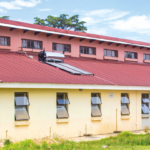Ntsoaki Motaung
A 30-year-old woman from Mafeteng, has pointed fingers at Mafeteng Hospital for a post-delivery infection she allegedly contracted during her stay at the hospital in the second week of October this year.
Admitted due to labour pains as her due date approached, Mpho (name changed for privacy) narrated that she found herself facing unforeseen complications that prolonged her hospital stay and ultimately led to a Caesarean delivery (C-section).
Mpho strongly believes that she acquired an infection from the hospital, resulting in complications with her caesarean wound shortly after her release.
This prompted her return to the hospital for further treatment.
Recalling her time in the maternity ward, Mpho described it as a crowded space with expectant mothers at various stages of childbirth, along with others facing their own set of challenges.
“Either they were going through labour pains or had some complications while others had their babies and were waiting to be released,” she recounted.
Mpho expressed deep frustration over the lack of cleanliness in the ward.
She revealed that the room she was admitted in remained unattended throughout her stay, with soiled sheets and unhygienic toilet facilities.
“Everyone had something unpleasant going on, and it was impossible to address basic hygiene needs. This is because most of us, if not all, were suffering from pain,” she lamented.
The dire conditions made it nearly impossible for Mpho and others in the ward to maintain personal hygiene, especially given their physical discomfort.
“Sitting on a toilet seat with blood, to cover it or clean it while in pain was not possible,” she said.
Convinced that the unhygienic environment directly contributed to her infection, Mpho detailed the rapid onset of health issues following her release.
“That is why I think the filthiness of the ward resulted in me having an infection. It did not take me long after I was released following delivery to get ill and suffer from the pain I had not experienced throughout my entire life,” she asserted.
Within hours of returning home, Mpho said she experienced escalating pain in her abdominal area, followed by noticeable swelling. Confounded and alarmed by these developments, she spent the subsequent day grappling with the discomfort and physical changes.
“At that moment, I thought I would recover, but things just kept getting worse. I could not even stand on my own, needing help just to shift in bed. It was when the wound stitches tore that my mother rushed me back to Mafeteng Hospital,” she recounted.
Upon returning, Mpho was re-admitted, and she noticed a significant change in cleanliness, signaling a potential lapse in sanitation protocols during her initial stay.
“It was only then when I came back, the cleaning was done in the ward. I arrived in the process of cleaning. I asked cleaners why they spend the whole week without cleaning and the response was there was no cleaning equipment like soap and detergents,” she stated.
Instead of improving, her condition deteriorated further, leading to her transfer to Queen Mamohato Memorial Hospital (QMMH) in Maseru, where she found hygiene conditions to be much better controlled.
QMMH serves as the country’s main referral healthcare facility. The 425-bed hospital, and a network of refurbished filter clinics, were built through a public-private partnership (PPP) initiative, with the Tšepong consortium as the principal contractor in the PPP agreement.
An independent study conducted by Boston University in 2012 found that QMMH delivered significantly more services and services of higher quality in 2012 than at baseline comparison of the Queen Elizabeth II hospital it replaced.
QMMH and four primary care clinics opened doors to patients in 2011 to replace the run-down 100-year-old Queen Elizabeth II hospital.
The hospital features eight operating rooms, a maternity wing including a 40-bed nursery, a 10-bed adult Intensive Care Unit (ICU), and an ophthalmology unit.
Netcare Hospital Group was subcontracted to manage QMMH, providing all clinical services required to operate the hospital and the primary care clinics but the PPP agreement was prematurely terminated with effect from August 31, 2021.
The hospital was handed over to the government.
The Ombudsman’s Report on Statutory Inspections at Public Hospitals in Lesotho 2023 highlighted issues with hygiene at Mafeteng Hospital.
The report revealed leaking taps and a lack of hot water in all departments and wards during the study period. Due to these issues, patients were forced to use basins instead of showers or bathtubs, putting them at risk of complications from hospital-acquired infections.
In response to the alarming allegations made by Mpho regarding unhygienic conditions at Mafeteng Hospital, the Ministry of Health’s public relations manager, Tumisang Mokoai, confirmed yesterday that they will be reaching out to the management of Mafeteng Hospital to seek answers.
While the ministry is committed to getting to the bottom of this issue, Mokoai did express uncertainty about the timeline for receiving a response from Mafeteng Hospital.
‘Mamonica Mak’hozonke Mokhesi, a Midwife and Chief Executive Officer at Healthdirect Pharmaceutical Solutions and Clinic, explained to this publication that reasons for undergoing a caesarean delivery can vary greatly from person to person.
Factors such as fetal distress, placenta previa, multiple pregnancies, breech presentation, and maternal health conditions can all contribute to the decision, Mokhesi said.
She emphasised that each pregnancy is unique, and the choice to perform a C-section is based on individual circumstances and what is in the best interest of both the mother and the baby.
Additionally, she said, when a woman undergoes a C-section while still at the health center, she remains under the close care and supervision of doctors and nurses, typically requiring a minimum of three days or more at the facility.
Mokhesi explained that an infection in a caesarean section wound can arise from various factors, including “bacterial contamination, inadequate wound care, a compromised immune system, obesity, prolonged rupture of membranes, and pre-existing infections”.
She said patients are thoroughly educated on wound care techniques.
“They receive essential medications, including antibiotics, and are strongly encouraged to incorporate more fruits and nutritious meals into their diet. Maintaining a clean environment, including the bedding our patients rest on, is also a key aspect of wound care,” she stated.
Mokhesi emphasized that ensuring sterile techniques are applied to equipment and the environment is crucial and stressed that without proper sterilization, infections can manifest even while the individual is still at the facility.
“Infections can occur before, during, or after labor, whether the patient is in the hospital or back at home. Recognising the signs of an infected C-section wound is vital,” she said.
She explained that these may encompass redness and swelling around the wound, heightened pain, warmth to the touch, discharge or pus, delayed healing, and the presence of a fever.
Although precise statistics may not be available, Mokhesi underscored that a significant number of women tragically succumb to infections stemming from their caesarean sections.
She highlighted the critical importance of comprehensive wound care and infection prevention measures in maternal healthcare.
Summary
- A 30-year-old woman from Mafeteng, has pointed fingers at Mafeteng Hospital for a post-delivery infection she allegedly contracted during her stay at the hospital in the second week of October this year.
- It did not take me long after I was released following delivery to get ill and suffer from the pain I had not experienced throughout my entire life,” she asserted.
- An independent study conducted by Boston University in 2012 found that QMMH delivered significantly more services and services of higher quality in 2012 than at baseline comparison of the Queen Elizabeth II hospital it replaced.

Your Trusted Source for News and Insights in Lesotho!
At Newsday Media, we are passionate about delivering accurate, timely, and engaging news and multimedia content to our diverse audience. Founded with the vision of revolutionizing the media landscape in Lesotho, we have grown into a leading hybrid media company that blends traditional journalism with innovative digital platforms.










